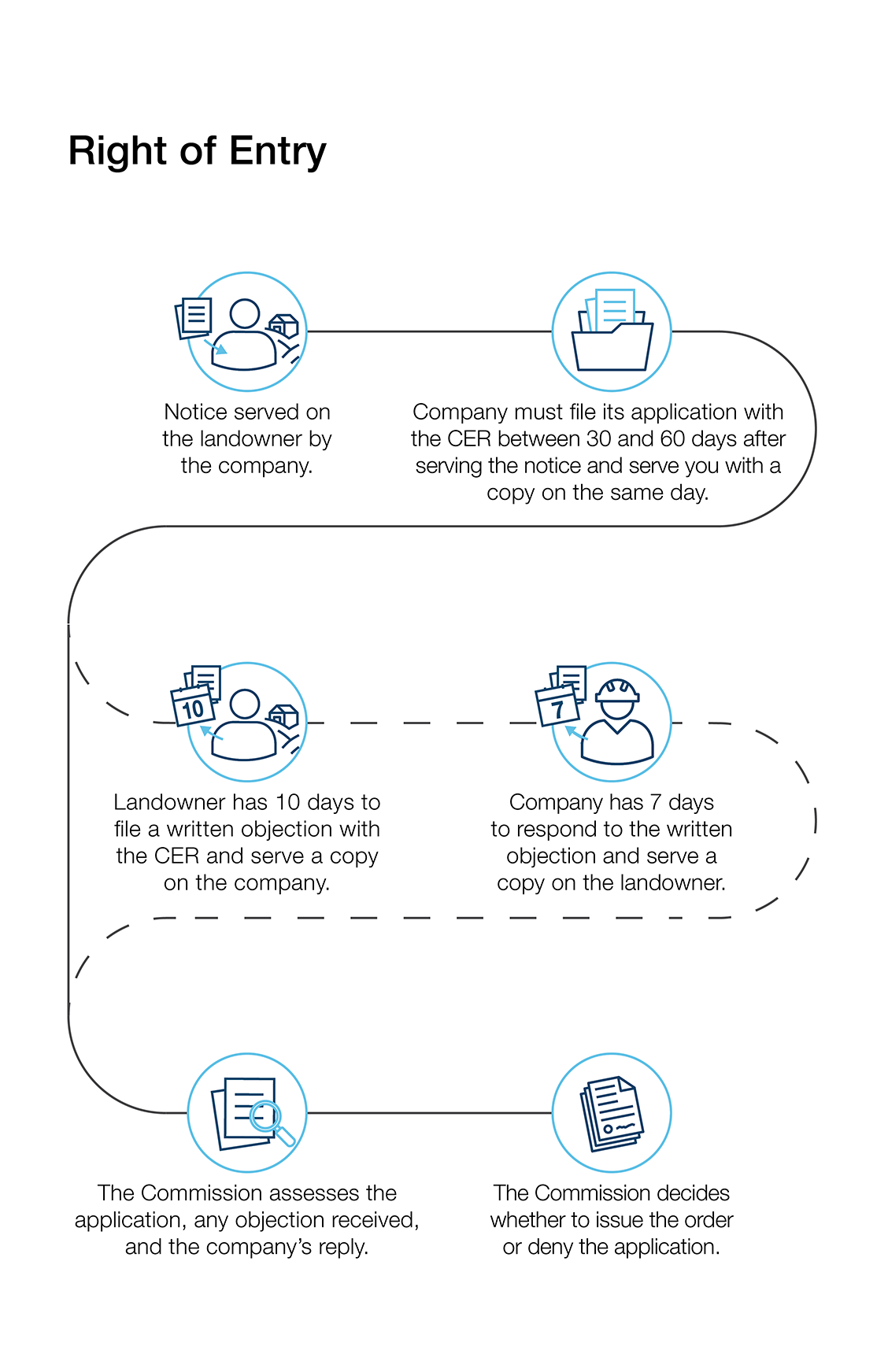Right-of-Entry Orders
This page explains what a right-of-entry order is, what you should do if contacted by a company, and how you can object to a right-of-entry order.
Questions you may have
- What is a right-of-entry order?
- What is in a company’s written notice to the landowner?
- How does a company apply for a right-of-entry order?
- What happens after a company files its right-of-entry application?
- How does the CER assess right-of-entry applications?
- What else is important to know?
What is a right-of-entry order?
If a company is unable to reach a land agreement for access to lands required for an authorized project, it may apply to the CER for a right-of-entry order. A right-of-entry order gives a company the right to immediately enter lands as soon as the order is registered, recorded, or filed at a local land titles or registry office. The CER has the authority to issue a right-of-entry order if it considers it appropriate to do so, and also to specify the terms and conditions to be followed.
The company will serve a notice on the owner of the lands if it intends to apply for a right-of-entry order from the CER.
For information about land agreements, see our website.

What is in a company’s written notice to the landowner?
Before a company submits its application for a right-of-entry order to the CER, it must let you know first so that you have a chance to object if you choose to.
To let you know about its plans to apply for the right to enter your lands, a company will send you a written notice.
The written notice will include:
- why the company needs the right-of-entry order
- when the company plans to file its application for a right-of-entry order with the CER
- when the company wishes to enter the requested land
- how long the company intends to have access to the land
- the CER’s address (so you can send us a written objection)
- your right to an advance of compensation payment if a right-of-entry order is issued and the amount of the advance that the company is prepared to give you
After a company serves you with the written notice, it then has between 30 and 60 days after the date it served you with a notice to apply to the CER for a right to enter your lands. These are specific timelines a company must follow when applying for a right-of-entry order.
How does a company apply for a right-of-entry order?
When a company applies for a right of entry order, it files its application on our website. It must follow what is stated in the CER Act, Rules of Practice and Procedure, and the CER’s Filing Manual. For example, an application must include a copy of the written notice it served on the owner of the lands and details about the lands. It must also include the terms and conditions it is proposing, which may or may not be the same as what it discussed with you.
The company must also serve the owner of the lands with a copy of the right-of-entry application.
What happens after a company files its right-of-entry application?
After a company files its right-of-entry application with the CER, a landowner can object to the company’s application. If you choose to object, you must file your written objection with the CER within 10 days after receiving a copy of the company’s application. In your written objection, give detailed reasons on why you object to the right of entry order and provide any comments you may have on any terms or conditions that should be included in the order. The company has up to 7 days to reply to a written objection and serve a copy of its reply to the landowner. The Commission will consider the information you and the company provide in making its decision on whether to grant the right-of-entry order.
To file a written objection, download and complete the CER form Objection to an Application for Right of Entry [PDF 163 KB] from our website or call the CER at 1-800-899-1265 (toll free) to request a copy from the CER Library. Follow the instructions within the form on how to submit it to the CER and be sure to give the company a copy as well.
How does the CER assess right-of-entry applications?
For each right of entry application, the CER assesses:
- whether the company has complied with the requirements as set out in the CER Act, Rules of Practice and Procedure, and the CER’s Filing Manual.
- the information in the company’s application
- any information from the landowner in a written objection
- any information from the company in its reply to the written objection
The Commission then decides whether to grant the order. If the Commission grants the order, it will determine the terms and conditions the company must follow. The company must also pay an advance on compensation even if the final amount is yet to be determined.
If the Commission denies the application, the company cannot proceed onto the lands.
What else is important to know?
- A right-of-entry order does not give a company ownership of the land.
- The CER’s ADR program offers voluntary and confidential facilitation and mediation services. Consider alternative dispute resolution (ADR) if you are having trouble negotiating a land agreement. ADR or direct negotiations can continue while the CER assesses a right-of-entry application.
- Land-related compensation disputes can be brought to the CER.
- Date modified:
